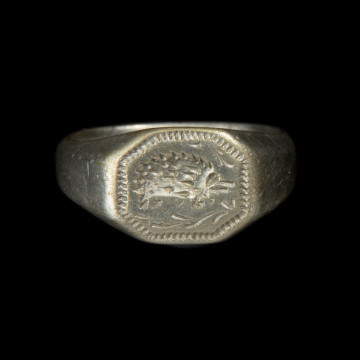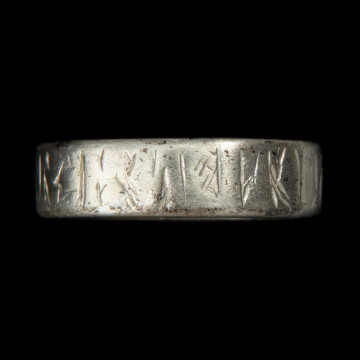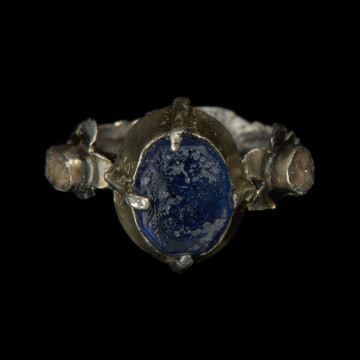
Signet ring with hedgehog
przełom XIV i XV wieku
National Museum in Szczecin
Part of the collection: Archaeological monuments of the Lublin region
The temple ring made of silver is a part of the treasure of Arabic coins (dirhems) of the 9th century from Lublin-Czechów. The treasure of dirhems found in 1945 probably consisted of about a thousand coins, which were arranged in rolls in a clay pot. The treasure also included two silver bars as well as an earring and a fragment of a bead. Both the bars and the dirhems, which were regularly broken into pieces, were used for payment purposes. The treasure was the capital of some merchant and came from Iraq (Baghdad?). The oldest coins were struck in 711/712, the youngest in 882/883.
The temple consists of a bow, on which a grape-shaped pendant is suspended. Ornaments of this type are characterised by a bow with one end cut straight and the other rolled into an eyelet. In the middle of the bow there are wreaths made of granules limited by rings of wire. In its lower part there is a pendant formed from several wreaths of granules, crowned with a granule set on a wire ring.
Such ornaments were used from the second half of the 9th to the mid-11th century.
Written and archaeological sources show that the Slavs conducted extensive local and long-distance trade. The treasure from Lublin-Czechów is undoubtedly the result of extensive contacts between Slavs living in the Lublin area in the 9th century.
Author / creator
Dimensions
cały obiekt: width: 9 cm
Object type
jewelry
Technique
filigree
Material
silver
Creation time / dating
Creation / finding place
Owner
The National Museum in Lublin
Identification number
Location / status

przełom XIV i XV wieku
National Museum in Szczecin

przełom XIV i XV wieku
National Museum in Szczecin

National Museum in Szczecin
DISCOVER this TOPIC
Museum of King Jan III's Palace at Wilanów
DISCOVER this PATH
Educational path